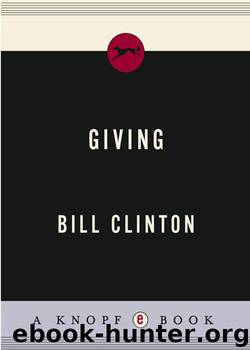Giving by Bill Clinton

Author:Bill Clinton
Language: eng
Format: mobi
ISBN: 9780307268921
Publisher: Knopf Doubleday Publishing Group
Published: 2007-09-04T10:00:00+00:00
EIGHT
Model Gifts
ONE THING THAT makes programs as diverse as Heifer International, the Self Employed Women’s Association in India, and New York’s Chess-in-the-Schools so appealing to givers is that they’re repeatable models that virtually always work. You know that if there are more animals, more microloans, more chess programs, those who receive them will be better off in predictable but gratifying ways. You don’t have to invent or reinvent the wheel; you just provide the money or volunteer time to bring the benefits of such programs to more people. Whenever I read about, observe, or participate in an exciting new project, I ask myself whether it can be replicated with predictable positive results and, if so, how.
In cases where different kinds of resources are required to achieve multiple goals, constructing such models is more difficult. That’s what Dr. Paul Farmer’s Partners In Health and my foundation’s HIV/AIDS Initiative are trying to do in Rwanda. Yes, we want to bring quality health care to people in isolated villages. But we also want to be able to say, “It works in Haiti. It works in Rwanda. This is the best, fastest, most cost-effective way to get health care to poor people everywhere. Please give money and time to spread it to everyone who needs it.”
In this chapter, I discuss some important efforts that could become repeatable models. Those that pursue several objectives at the same time present significant challenges to donors in terms of time, skills, or money, but they’re all worthy of support just for what they’re doing, and they have at least the potential to be greatly expanded.
In 2000, the United Nations adopted the Millennium Development Goals. It pledged to cut in half the number of people living in extreme poverty (less than $1 a day) by 2015; to reduce by half the number of people suffering from hunger; to ensure all children at least a primary school education (each year of schooling adds 10 percent a year to the income of a person in a poor country); to end the disparity in school attendance between boys and girls; to reduce mortality among children under five by two-thirds and maternal mortality by three-quarters; to cut in half the number of people without access to clean water; and to halt and begin to reverse the incidence of HIV/AIDS, TB, malaria, and other major infectious diseases.
In 1999, the G8, the world’s major economic powers, launched the millennium debt relief initiative to forgive the debts of the poorest highly indebted nations if they protected human rights and agreed to put all their savings into education, health, or economic development. In 2005, the G8 leaders pledged another round of debt relief and promised to double aid to Africa, to $50 billion per year. But no one believes that even these big steps will be enough to enable the poorest African nations to reach the Millennium Development Goals. Almost half the people in sub-Saharan Africa are living in poverty, about one-third are malnourished, more than 300
Download
This site does not store any files on its server. We only index and link to content provided by other sites. Please contact the content providers to delete copyright contents if any and email us, we'll remove relevant links or contents immediately.
| U.K. Prime Ministers | U.S. Presidents |
Waking Up in Heaven: A True Story of Brokenness, Heaven, and Life Again by McVea Crystal & Tresniowski Alex(37676)
Empire of the Sikhs by Patwant Singh(22978)
We're Going to Need More Wine by Gabrielle Union(18972)
Hans Sturm: A Soldier's Odyssey on the Eastern Front by Gordon Williamson(18489)
Leonardo da Vinci by Walter Isaacson(13189)
The Radium Girls by Kate Moore(11930)
Tools of Titans by Timothy Ferriss(8224)
Educated by Tara Westover(7946)
How to Be a Bawse: A Guide to Conquering Life by Lilly Singh(7394)
Permanent Record by Edward Snowden(5743)
The Last Black Unicorn by Tiffany Haddish(5558)
The Rise and Fall of Senator Joe McCarthy by James Cross Giblin(5230)
Promise Me, Dad by Joe Biden(5088)
The Wind in My Hair by Masih Alinejad(5034)
A Higher Loyalty: Truth, Lies, and Leadership by James Comey(4851)
The Crown by Robert Lacey(4731)
The Iron Duke by The Iron Duke(4293)
Joan of Arc by Mary Gordon(4017)
Stalin by Stephen Kotkin(3883)
